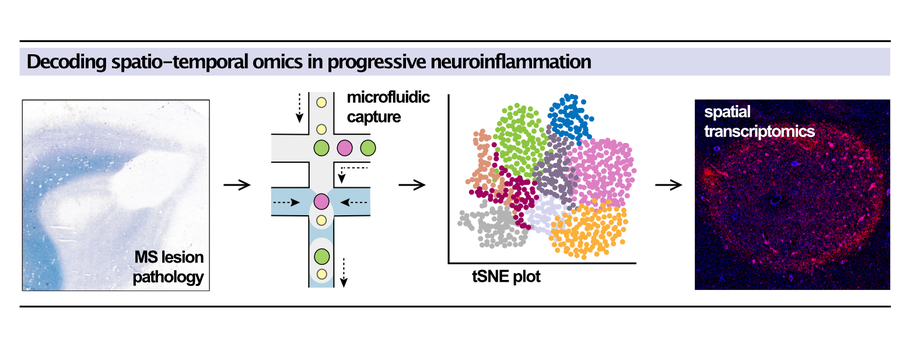Sie befinden sich hier
Inhalt

Senior Attending Physician
Heisenberg Professor of Translational Neurobiology
Division Chief Neuroimmunology, Department of Neurology
Research focus neurology and inflammation, Department of Neurology
Multiple sclerosis (MS) is a prototypic chronic-inflammatory disease of the central nervous system characterized by multiple lesions across gray and white matter areas. Deconvoluting the spatio-temporal cellular and molecular landscape is therefore key to understanding underlying disease mechanisms and to develop cell-type specific precision therapies.
The Schirmer lab (www.schirmerlab.com) has a wide experience in single-cell RNA-sequencing and transgenic model systems focusing on neuroglial and immune cell subtypes in neuroinflammatory diseases. The focus in the lab is on neuroglial and immune cell pathologies in progressive inflammatory diseases of the central and peripheral nervous system, such as MS and myositis.
Research in the Schirmer lab integrates a broad spectrum of multi-omics approaches and utilizes work with experimental models and human tissues in a synergistic way to track-down reactive cellular states in compartmentalized progressive neuroinflammation.

Selected national and international joint research projects
DFG: FOR 5705 “NeuroFlame - Defence and demise of inflamed neurons”
- Subproject (together with T. Kuner): Decoding vulnerability of sensorimotor neurons to neuroinflammation. Duration: 2024 – 2028
MWK: Multimodal characterization of liquor-specific signatures in long-COVID. Duration 2023 – 2025 (together with Claudia Schilling and Hayrettin Tumani)
DFG: GRK 2727 “InCheck”
Subproject: Decoding and regulating iron homeostasis in myeloid cells in neuroinflammation. Duration: 2022 – 2026
DFG: Decoding cell type-specific molecular traits along functional circuits in inflammatory demyelination. Duration: 2022 – 2025
DFG: FOR 2690 “Translational Pruritus Research” Subproject 4: Transcriptomic patterns of dermal Schwann cell reactivity in neuropathic itch and pain. Duration: 2022 – 2024
EU: ERC starting grant “Decoding spatio-temporal omics in progressive neuroinflammation (DecOmPress)”. Duration: 2021 – 2025
DFG: Deciphering alcohol addiction-associated gene regulation changes on a single cell level. Duration: 2020 – 2023 (together with Philipp Koch)
Hertie foundation: medMS MyLab Research Grant. Duration: 2019 - 2023
National Multiple Sclerosis Society USA: Understanding and modulating astrocyte diversity in MS and experimental demyelination. Duration: 2019 – 2020
Legend: DFG = German Research Foundation, EU = European Union, MWK = Ministry of Science, Research and the Arts
Selected publications
- Cell type mapping reveals tissue niches and interactions in subcortical multiple sclerosis lesions.
Lerma-Martin C, Badia-i-Mompel P, Ramirez Flores RO, Sekol P, Schäfer PSL, Riedl CJ, Hofmann A, Thäwel T, Wünnemann F, Ibarra-Arellano MA, Trobisch T, Eisele P, Schapiro D, Haeussler M, Hametner S, Saez-Rodriguez J, Schirmer L. Nature Neuroscience (2024) Epub November 5 -
Cell type mapping of inflammatory muscle diseases highlights selective myofiber vulnerability in inclusion body myositis.
Wischnewski S, Thäwel T, Ikenaga C, Kocharyan A, Lerma-Martin C, Zulji A, Rausch HW, Brenner D, Thomas L, Kutza M, Wick B, Trobisch T, Preusse C, Haeussler M, Leipe J, Ludolph A, Rosenbohm A, Hoke A, Platten M, Weishaupt JH, Sommer CJ, Stenzel W, Lloyd TE, Schirmer L. Nature Aging (2024) 4 (7): 969-983. - Neuron-oligodendrocyte potassium shuttling at nodes of Ranvier protects against inflammatory demyelination.
Kapell H, Fazio L, Dyckow J, Schwarz S, Cruz-Herranz A, Mayer C, Campos J, D'Este E, Möbius W, Cordano C, Pröbstel AK, Gharagozloo M, Zulji A, Narayanan Naik V, Delank A, Cerina M, Müntefering T, Lerma-Martin C, Sonner JK, Sin JH, Disse P, Rychlik N, Sabeur K, Chavali M, Srivastava R, Heidenreich M, Fitzgerald KC, Seebohm G, Stadelmann C, Hemmer B, Platten M, Jentsch TJ, Engelhardt M, Budde T, Nave KA, Calabresi PA, Friese MA, Green AJ, Acuna C, Rowitch DH, Meuth SG, Schirmer L. J Clin Invest (2023) 133(7):e164223. - Cross-regional homeostatic and reactive glial signatures in multiple sclerosis.
Trobisch T, Zulji A, Stevens NA, Schwarz S, Wischnewski S, Öztürk M, Perales-Patón J, Haeussler M, Saez-Rodriguez J, Velmeshev D, Schirmer L. Acta Neuropathol (2022) 144(5):987-1003 - Diversity and Function of Glial Cell Types in Multiple Sclerosis.
Schirmer L, Schafer DP, Bartels T, Rowitch DH, Calabresi PA. Trends Immunol (2021) 42(3):228-247. - Gut microbiota-specific IgA+ B cells traffic to the CNS in active multiple sclerosis.
Pröbstel AK, Zhou X, Baumann R, Wischnewski S, Kutza M, Rojas OL, Sellrie K, Bischof A, Kim K, Ramesh A, Dandekar R, Greenfield AL, Schubert RD, Bisanz JE, Vistnes S, Khaleghi K, Landefeld J, Kirkish G, Liesche-Starnecker F, Ramaglia V, Singh S, Tran EB, Barba P, Zorn K, Oechtering J, Forsberg K, Shiow LR, Henry RG, Graves J, Cree BAC, Hauser SL, Kuhle J, Gelfand JM, Andersen PM, Schlegel J, Turnbaugh PJ, Seeberger PH, Gommerman JL, Wilson MR, Schirmer L, Baranzini SE. Sci Immunol (2020) 5(53):eabc7191. - Neuronal vulnerability and multilineage diversity in multiple sclerosis.
Schirmer L, Velmeshev D, Holmqvist S, Kaufmann M, Werneburg S, Jung D, Vistnes S, Stockley JH, Young A, Steindel M, Tung B, Goyal N, Bhaduri A, Mayer S, Engler JB, Bayraktar OA, Franklin RJM, Haeussler M, Reynolds R, Schafer DP, Friese MA, Shiow LR, Kriegstein AR, Rowitch DH. Nature (2019) 573(7772):75-82. - Single-cell genomics identifies cell type-specific molecular changes in autism.
Velmeshev D, Schirmer L, Jung D, Haeussler M, Perez Y, Mayer S, Bhaduri A, Goyal N, Rowitch DH, Kriegstein A. Science (2019) 364(6441):685-9. - Single-Cell High-Throughput Technologies in Cerebrospinal Fluid Research and Diagnostics.
Lanz TV, Pröbstel AK, Mildenberger I, Platten M, Schirmer L. Front Immunol (2019) 10:1302. - Oligodendrocyte-encoded Kir4.1 function is required for axonal integrity.
Schirmer L, Möbius W, Zhao C, Cruz-Herranz A, Ben Haim L, Cordano C, Shiow LR, Kelley KW, Sadowski B, Timmons G, Pröbstel AK, Wright JN, Sin JH, Devereux M, Morrison DE, Chang SM, Sabeur K, Green AJ, Nave KA, Franklin RJ, Rowitch DH. eLife (2018) 7:651.
Kontextspalte
Contact
Medical Faculty Mannheim
Heidelberg University
Theodor-Kutzer-Ufer 1-3
68167 Mannheim
lucas.schirmer@medma.uni-heidelberg.de
